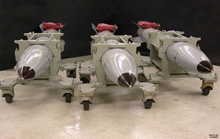June 30, 2006
NNSA Achieves Significant Milestone for B61 Bomb
Stockpile Stewardship Program Uses Cutting-Edge Science To Certify Weapons Without Underground Nuclear Testing
 WASHINGTON, DC - The Department of Energy's National Nuclear Security Administration (NNSA) has completed a six-year effort to deliver the first refurbished B61 nuclear bomb. This program will extend the life of the B61 Mod-7 and Mod-11 strategic bombs in the U.S. nuclear weapons stockpile. WASHINGTON, DC - The Department of Energy's National Nuclear Security Administration (NNSA) has completed a six-year effort to deliver the first refurbished B61 nuclear bomb. This program will extend the life of the B61 Mod-7 and Mod-11 strategic bombs in the U.S. nuclear weapons stockpile.
It is part of an ambitious effort, which helps to ensure that the nation's aging nuclear weapons stockpile is capable of meeting national defense requirements without conducting underground nuclear tests. The purpose of the B61 refurbishment is to extend the bomb's life by 20 years. Every part of NNSA's nuclear weapons complex contributed to this effort through design, production or review work.
"Completing the B61 first production unit is an important step in keeping our nuclear weapons stockpile safe and reliable. Our nuclear weapons were never intended to last this long and they were not designed to be taken apart, so it is a credit to our scientists and engineers across the complex who have come together to deliver this unit on time," said NNSA Deputy Administrator for Defense Programs Tom D'Agostino.
 The B61 bombs are an integral part of our nation's strategic defense and are the oldest weapons in the nuclear stockpile, many of which were originally produced in the late 1960s and early 1970s. The B61-7/11s are slated to be refurbished by fiscal year 2009. The B61 bombs are an integral part of our nation's strategic defense and are the oldest weapons in the nuclear stockpile, many of which were originally produced in the late 1960s and early 1970s. The B61-7/11s are slated to be refurbished by fiscal year 2009.
No new nuclear weapons have been produced since the end of the Cold War. At the time of production, these weapons were not intended to last indefinitely, and over time nuclear warheads deteriorate, even when kept in storage. Therefore, to maintain a credible nuclear deterrent without conducting underground tests, NNSA uses science-based research to extend the lifetime of nuclear weapons. Through the Stockpile Stewardship Program, NNSA works extensively to develop solutions to extend the lifetime of a warhead or bomb. Life extension work includes identifying and correcting potential technical issues within each weapon, and refurbishing and replacing certain components.
Established by Congress in 2000, NNSA is a semi-autonomous agency within the U.S. Department of Energy responsible for enhancing national security through the military application of nuclear science. NNSA maintains and enhances the safety, security, reliability and performance of the U.S. nuclear weapons stockpile without nuclear testing; works to reduce global danger from weapons of mass destruction; provides the U.S. Navy with safe and effective nuclear propulsion; and responds to nuclear and radiological emergencies in the U.S. and abroad.
Media contact(s):
NNSA Public Affairs (202) 586-7371
|